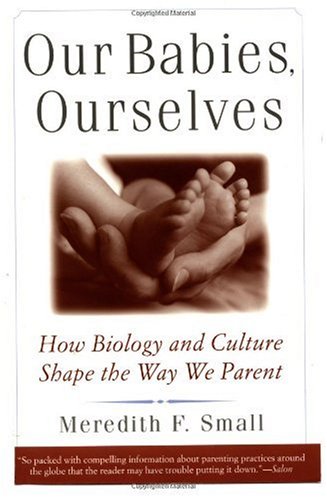Altricial Versus Precocial Infants
Not all babies are the same. Human babies are rather helpless, interested mostly in food, sleeping, eating, defecating, and comfort. Compare human babies with newborn deer. When fawns are born, they immediately stand up and soon are able to run away from danger. Scientists call these two types of babies in the animal kingdom altricial and precocial. Altricial infants are born helpless, usually after a short gestation or pregnancy, and their brains tend to be not quite finished. Precocial babies usually spend more time in the womb, are more alert at birth with eyes open and a brain able to control their limbs and make them move appropriately; their central nervous systems are more advanced, compared with those of altricial infants. Altricial infants tend to be small-bodied, small-brained, and fast-breeding—^such as mice. Precocial infants tend to be largebodied, big-brained, and slow-breeding—^such as gorillas.
Both are reasonable alternative paths to survival; the altricial baby tends to grow faster after birth, whereas the precocial baby has gone through more of its development while still inside the womb. The size of die brain of typical precocial babies at birth, for example, is 4.5 times bigger than the brain of typical altricial infants of the same body weight. But the difference disappears later in life. The altricial brain grows to 7.5 times its size from birth, whereas the precocial brain grows only 2.5 times; in other words, the smaller brain grows almost three times as fast once it is out of the womb.^ This overall physical and ecological framework is necessary to put our own species into perspective. What dictates a strategy for a precocial or an altricial infant, and why did the human path lead to dependent babies? There are, of course, good biological reasons why our fetuses are born at a certain average time and at a particular size.
[...]
These three birthing strategies—altricial, precocial, and secondary altricial—are all related to a complex of constraints and adaptations that molds one species or another. Ecologists see these strategies as a contin¬ uum. At one end are the species that produce a large number of offspring at a rapid rate while investing little in each infant, such as insects (these are called r-sekcud species). At the other end of the continuum are species that reproduce only occasionally and invest heavily in each infant (called Kselected species).^ Mice, for example, have done best by producing large litters of altricial infants that stay in a nest until they develop. I For most imgulates, the horned and hoofed animals, evolution has opted for large animals with alert, fast precocial babies. And the human line is defined by big-brained babies that come out unfinished. There is no easy answer as to why one path is taken rather than another. Sometimes chance may nudge a species in a certain direction. More often, the pattern can be explained as an adaptation to a particular set of environmental circumstances that favor this or that physical change. So far, we only know that the evolutionary history of humans has moved toward favoring big brains, which in turn necessitated developmental and physiological consequences at birth and during infancy.
Notes:
Two evolutionary strategies for animal infants, born ready versus born helpless but capable of growing into a more advanced state ultimately.
Folksonomies: evolution babies infancy birth
Taxonomies:
/family and parenting/babies and toddlers (0.616253)
/science/biology/zoology/endangered species (0.269952)
/family and parenting/motherhood/pregnancy (0.269043)
Keywords:
altricial infants (0.997052 (negative:-0.445494)), precocial babies (0.811847 (negative:-0.476450)), Versus Precocial Infants (0.750637 (negative:-0.341905)), typical precocial babies (0.684410 (negative:-0.476450)), typical altricial infants (0.676509 (negative:-0.558920)), human babies (0.655811 (negative:-0.312582)), fast precocial babies (0.640837 (neutral:0.000000)), central nervous systems (0.578632 (neutral:0.000000)), human path lead (0.544867 (negative:-0.356570)), certain average time (0.538581 (negative:-0.271944)), animal infants (0.536672 (negative:-0.341905)), dependent babies (0.497450 (negative:-0.356570)), big-brained babies (0.476038 (neutral:0.000000)), advanced state (0.423634 (positive:0.412606)), newborn deer (0.417514 (neutral:0.000000)), altricial brain (0.416377 (neutral:0.000000)), short gestation (0.416349 (negative:-0.469310)), precocial brain (0.415864 (negative:-0.249938)), evolutionary strategies (0.414176 (negative:-0.341905)), altricial baby (0.413808 (positive:0.302768)), precocial baby (0.413385 (negative:-0.311084)), animal kingdom (0.406119 (neutral:0.000000)), birth (0.402550 (negative:-0.012184)), body weight (0.401520 (negative:-0.558920)), die brain (0.396908 (negative:-0.476450)), smaller brain (0.396704 (positive:0.236354)), r-sekcud species (0.393398 (neutral:0.000000)), ecological framework (0.391482 (positive:0.236354)), big brains (0.390806 (negative:-0.213843)), contin¬ uum (0.390692 (positive:0.348755))
Entities:
precocial:Degree (0.821310 (neutral:0.000000))
Concepts:
Infant (0.953971): dbpedia | freebase | opencyc
Childbirth (0.793952): dbpedia | freebase
Nervous system (0.612674): dbpedia | freebase | opencyc
Pregnancy (0.593040): dbpedia | freebase | opencyc
Central nervous system (0.587677): dbpedia | freebase | opencyc
Fetus (0.554571): dbpedia | freebase | opencyc
Brain (0.521182): dbpedia | freebase | opencyc
Human brain (0.456904): dbpedia | freebase





